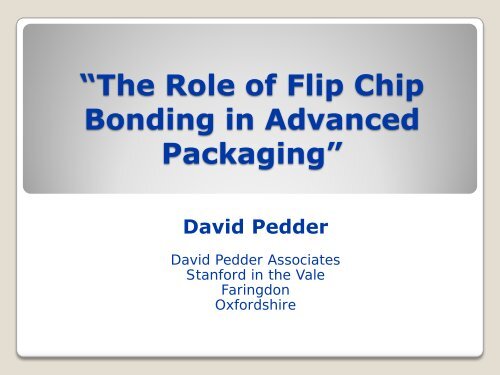The Role of Flip Chip
The Role of Flip Chip
The Role of Flip Chip
Create successful ePaper yourself
Turn your PDF publications into a flip-book with our unique Google optimized e-Paper software.
“<strong>The</strong> <strong>Role</strong> <strong>of</strong> <strong>Flip</strong> <strong>Chip</strong><br />
Bonding in Advanced<br />
Packaging”<br />
David Pedder<br />
David Pedder Associates<br />
Stanford in the Vale<br />
Faringdon<br />
Oxfordshire
“<strong>The</strong> <strong>Role</strong> <strong>of</strong> <strong>Flip</strong> <strong>Chip</strong> Bonding in Advanced<br />
Packaging”<br />
Outline<br />
<strong>Flip</strong> <strong>Chip</strong> Definitions<br />
<strong>Flip</strong> <strong>Chip</strong> Technologies<br />
<strong>Flip</strong> <strong>Chip</strong> Properties<br />
<strong>Flip</strong> <strong>Chip</strong> Applications<br />
<strong>Flip</strong> <strong>Chip</strong> – <strong>The</strong> Future<br />
Summary & Conclusions
<strong>Flip</strong> <strong>Chip</strong> Definitions *<br />
<strong>Flip</strong> “ A mixture <strong>of</strong> beer & spirits<br />
sweetened with sugar and heated<br />
with a hot iron”<br />
<strong>Chip</strong> “ A counter used in games <strong>of</strong> chance”<br />
Bond “ in a state <strong>of</strong> serfdom or slavery”<br />
or …..<br />
* Shorter Oxford English Dictionary, Vol. 1, 1970
<strong>Flip</strong> <strong>Chip</strong> Definitions *<br />
• <strong>Flip</strong> <strong>Chip</strong> Bonding - <strong>The</strong> connection <strong>of</strong> a device,<br />
bond pads face down, onto a substrate with a<br />
matching array <strong>of</strong> bond pads
<strong>Flip</strong> chip bonding history<br />
• 1960<br />
– IBM develops Solid Logic Technology<br />
• 1964<br />
– Totta and Miller develop the C4 process<br />
– C4 = Controlled Collapse <strong>Chip</strong> Connection<br />
IBM<br />
Corporation<br />
IBM Corporation
<strong>Flip</strong> chip bonding evolution<br />
• 3 bonds/chip 1964 Cu ball transistor<br />
• 10-30 bonds/chip 1970 C4 SSIC<br />
• 120 bonds/chip 1980 C4 LSI<br />
• 354 bonds/chip 1985 C4 VLSI<br />
• 2100 bonds/chip 2000 C4 SoC
<strong>Flip</strong> chip bonding advantages<br />
• Very high interconnection density<br />
Area array and peripheral bonds possible<br />
Fine pitch (50m) connections possible<br />
Improved high frequency/speed<br />
performance<br />
Short/repeatable connection length<br />
Reduced electrical parasitics<br />
Minimal component footprint<br />
True chip scale package<br />
Pac Tech GmbH<br />
National Semiconductor Corp
<strong>Flip</strong> chip bonding technologies<br />
• Solder flip chip<br />
• Adhesive flip chip<br />
• Solid phase flip chip
Solder flip chip bonding<br />
• Common uses<br />
<strong>Flip</strong> chip on board (FCOB)<br />
<strong>Flip</strong> chip in package (FCIP)<br />
System in package (SiP)<br />
Hybrid modules<br />
• Solder advantages<br />
Self aligning (
As deposited<br />
oxide<br />
Solder flip chip bonding<br />
Bumping<br />
reflowed<br />
Pb<br />
CrCu/CuSn<br />
AlSi<br />
Device<br />
passivation<br />
• Controlled dewetting<br />
• CrCuAu wettable metal<br />
• 95Pb5Sn solder<br />
Bonding<br />
Device<br />
Substrate<br />
• Limited wettable areas<br />
• Surface tension controlled<br />
alignment<br />
stand-<strong>of</strong>f
Solder flip chip bond design<br />
mg/n<br />
S p.A<br />
S<br />
Substrate<br />
• Balance <strong>of</strong> surface tension & gravitational forces<br />
• Conservation <strong>of</strong> volume allows joint design<br />
• Surface tension dominates<br />
• Double truncated sphere approximation<br />
• Sets solder uniformity requirements, mixed bond design
Solder flip chip bond design<br />
= 0 o = 180 o<br />
• Solder volume uniformity requirements<br />
Perimeter volume
Solder flip chip bond design<br />
As deposited<br />
reflowed<br />
bonded<br />
125<br />
70<br />
33.5<br />
20.8<br />
13.3<br />
6.9<br />
3.0<br />
• Matched 18 & 70 m bond design<br />
43<br />
18<br />
23.8
Solder flip chip bond alignment<br />
• Solder vernier structure<br />
• Alignment < 2m vernier resolution
Solder bumping<br />
• Wafer level processing<br />
• Under bump metallisation (UBM)<br />
Ohmic contact<br />
Adhesion/barrier between the pad and the bump<br />
Wettable surface<br />
• Common UBM deposition techniques<br />
Plating<br />
Evaporation<br />
Sputtering<br />
• Typical UBMs<br />
Ni/Au<br />
Cr/CrCu/Cu/Au<br />
NiV/Cu<br />
TiW<br />
IC Interconnect
Solder bumping<br />
• Typical solder alloys<br />
High melting point Lead/Tin (95/5) solder<br />
Eutectic Tin/Lead (63/37) solder<br />
Lead-free solder: Tin/Copper/Silver etc<br />
Eutectic Gold/Tin (80/20) solder<br />
• Common solder deposition techniques<br />
Evaporation<br />
Plating<br />
Stencil printing<br />
Laser dispense<br />
Mould transfer<br />
IC Interconnect
Solder bumping underfill<br />
• Required for flip chip on board (FCOB) reliability<br />
• Underfill process<br />
underfill dispense<br />
underfill cure<br />
Dispense needle<br />
<strong>Flip</strong> <strong>Chip</strong> Integrated Circuit<br />
Laminate Printed Circuit Board<br />
Underfill drawn<br />
under die by capillary<br />
action
h<br />
Solder bumping reliability<br />
<br />
• Low cycle thermal fatigue<br />
d<br />
Si<br />
substrate<br />
solder<br />
• Factors<br />
Cycle amplitude<br />
<strong>Chip</strong> size<br />
CTE mismatch<br />
Solder alloy<br />
Bond geometry<br />
Use <strong>of</strong> underfill
Adhesive flip chip bonding<br />
• Common uses<br />
<strong>Chip</strong> on glass (COG)<br />
<strong>Chip</strong> on flex (COF)<br />
• Adhesive advantages<br />
Fine pitch (50µm)<br />
Low temperature process<br />
No separate underfill required (Anisotropic Conductive Adhesive)<br />
Lead-free
Adhesive flip chip wafer bumping<br />
• Wafer level processing<br />
• Common bump deposition techniques<br />
Gold stud bumps formed with a gold ball bonder<br />
Electroless plated nickel bumps/thin immersion gold<br />
Electrolytic plated gold bumps, typically on a TiW UBM<br />
Polymer bumps (selectively placed conducting adhesive)<br />
Hesse & Knipps<br />
Citizen Watch Co., Ltd.
Adhesive flip chip bonding<br />
Anisotropic<br />
Conductive Film<br />
(conductive particles<br />
in a non-conductive<br />
adhesive)<br />
Heated pick-up<br />
tool<br />
Integrated Circuit Die<br />
Substrate
Adhesive flip chip bonding
Solid phase flip chip bonding<br />
• Common uses<br />
<strong>Flip</strong> chip on board (FCOB)<br />
<strong>Flip</strong> chip in package (FCIP)<br />
System in package (SIP)<br />
Hybrid modules<br />
• Die pads require bumping<br />
Gold stud bumps<br />
Electroplated gold bumps<br />
Hesse & Knipps
Solid phase bonding processes<br />
Heat, compression<br />
Heat, compression,<br />
ultrasonic vibration<br />
<strong>The</strong>rmocompression <strong>The</strong>rmosonic<br />
Hesse & Knipps<br />
Hesse & Knipps
Solid phase bump coining<br />
Individual/gang coining
Solder flip chip bond properties<br />
Bonding Parameter Wire Bond TAB <strong>Flip</strong> <strong>Chip</strong><br />
Material(s) Al Au Cu Pb-Sn<br />
Melting temperature, o C 660 1064 1084 310 or 183<br />
Typical bond geometry 25m diameter 25x100m tape x 100m diameter<br />
x 2.5mm length 2.5mm length 80m height<br />
Typical pitch, m 100m perimeter 200m perimeter 200m area<br />
Bond strength, grams 6 10 50 20<br />
Bond resistance, m.ohms 142 122 17 1.2<br />
Interbond capacitance, pF 0.025 0.025 0.006 0.001<br />
Bond inductance, nH 2.6 2.6 2.1
<strong>Flip</strong> chip industry infrastructure<br />
• Wafer bumping<br />
Over 20 companies established<br />
• <strong>Flip</strong> chip substrates<br />
~ 20 companies established<br />
• <strong>Flip</strong> chip equipment<br />
Over 20 manufacturers established<br />
• <strong>Flip</strong> chip assembly services<br />
Over 30 subcontractors<br />
Tyco Electronics
<strong>Flip</strong> chip applications<br />
• Silicon devices<br />
Discretes<br />
RFICs - SiGe<br />
ASICs, Microprocessors & System-on-<strong>Chip</strong><br />
• GaAs devices<br />
• Integrated Passive Devices (IPDs)<br />
• System-in-Package (SiPs)<br />
• 3D Integration<br />
• Photonics Assemblies<br />
device and substrate alignment<br />
spatial light modulator<br />
• Sensors<br />
Uncooled, cooled IR sensors<br />
HDD readers
<strong>Flip</strong> chip discretes<br />
Source: National Semiconductor.
<strong>Flip</strong> chip on lead<br />
SOT23 MLP<br />
Source: Carsem.
<strong>Flip</strong> chip RFIC<br />
Bluetooth Radio Module<br />
RF IC: 46 flip chip bonds at 200m pitch<br />
Thin film integrated passives substrate<br />
40 BGA balls at 0.80mm pitch<br />
Source: Intarsia.
<strong>Flip</strong> chip CPU IC<br />
Pentium II chip : 2100 flip chip bonds at 250m pitch<br />
BGA substrate<br />
570 BGA balls at 1.27mm pitch<br />
mini-cartridge substrate<br />
240 way connector<br />
Source: Intel
Source:GMMT<br />
<strong>Flip</strong> chip GaAs
Source:CMD<br />
<strong>Flip</strong> chip IPDs<br />
Source: Telephus
<strong>Flip</strong> chip SiPs<br />
Source: Intarsia. Source: STMicroelectronics
20<br />
18<br />
16<br />
14<br />
12<br />
10<br />
8<br />
6<br />
4<br />
2<br />
0<br />
bare<br />
die<br />
<strong>Flip</strong> chip SiP utilisation<br />
SiP technologies - die level<br />
CSP Other 2D 3D wire<br />
bond<br />
flip<br />
chip<br />
solder<br />
ball<br />
die packaging die placement die interconnection<br />
Source: eKTN<br />
TSV
<strong>Flip</strong> chip 3D integration<br />
Source: iNEMI, IMEC
<strong>Flip</strong> chip 3D integration<br />
Source: iNEMI, Renesas
16Gb<br />
memory<br />
(8 x 2Gb)<br />
560μm<br />
<strong>Flip</strong> chip 3D integration<br />
TSV<br />
Micro<br />
bump<br />
50μm thick <strong>Chip</strong><br />
Laser<br />
drilled<br />
via<br />
Source: iNEMI, Samsung
Source: GMMT<br />
<strong>Flip</strong> chip photonics devices
<strong>Flip</strong> chip IR sensor devices<br />
Source: Irisys
<strong>Flip</strong> chip hard disc sensor devices<br />
Source: Seagate
<strong>Flip</strong> <strong>Chip</strong> Trends<br />
Much wider uptake<br />
2% to 10% all devices<br />
IPDs & high I/O devices<br />
Growth <strong>of</strong> infrastructure<br />
New technologies<br />
Cu pillar bumping<br />
Lower cost processes<br />
Finer pitch<br />
<strong>Chip</strong>-to-chip bonding<br />
Improved reliability<br />
<strong>Flip</strong> <strong>Chip</strong> Bonding<br />
Source: TechSearch International, Inc.<br />
Source: <strong>Chip</strong>Works
<strong>Flip</strong> <strong>Chip</strong> Futures<br />
• <strong>Flip</strong> chip usage will continue to grow<br />
• Drivers<br />
High I/O applications<br />
Where size is critical<br />
High frequency/speed applications<br />
IPDs, SiPs, 3D integration<br />
<strong>Flip</strong> <strong>Chip</strong> Bonding
Thank you for your attention<br />
David Pedder<br />
David Pedder Associates<br />
18, Ock Meadow, Stanford in the Vale<br />
Faringdon, Oxfordshire SN7 8LN<br />
DJPedderDPA@aol.com<br />
+44 (0)1367 718420<br />
+44 (0)7899 952230
















